Have you ever gone through puberty so dramatic that it turned you into a completely different species?
If so, you can probably relate to Nanotyrannus.
Paleontologists are polarized by the predatory dinosaur “Nanotyrannus”. To some, Nanotyrannus was a medium-sized member of the Tyrannosaurid family that lived alongside its famous cousin, Tyrannosaurus. Others believe that Nanotyrannus and Tyrannosaurus were one and the same. For decades, paleontologists have passionately debated whether Nanotyrannus is its own distinct species or simply a smaller version of Tyrannosaurus rex. To explore this question, we must examine what lies at the heart of one of paleontology’s greatest conflicts.
The first thing to look at is whether the two lived at the same time. Nanotyrannus lived during the late Cretaceous period of North America, some 67 million years ago. All known Nanotyrannus specimens originated from Montana’s Hell Creek formation, a location famous for its abundance of Tyrannosaurus fossils. Tyrannosaurus fossils in the formation also date to the late Cretaceous, 67-66 million years ago. Clearly, Nanotyrannus and Tyrannosaurus lived alongside each other. But were they one and the same? To dig further into this question (no pun intended), we need to examine the specimens of Nanotyrannus and see how they compare to Tyrannosaurus.
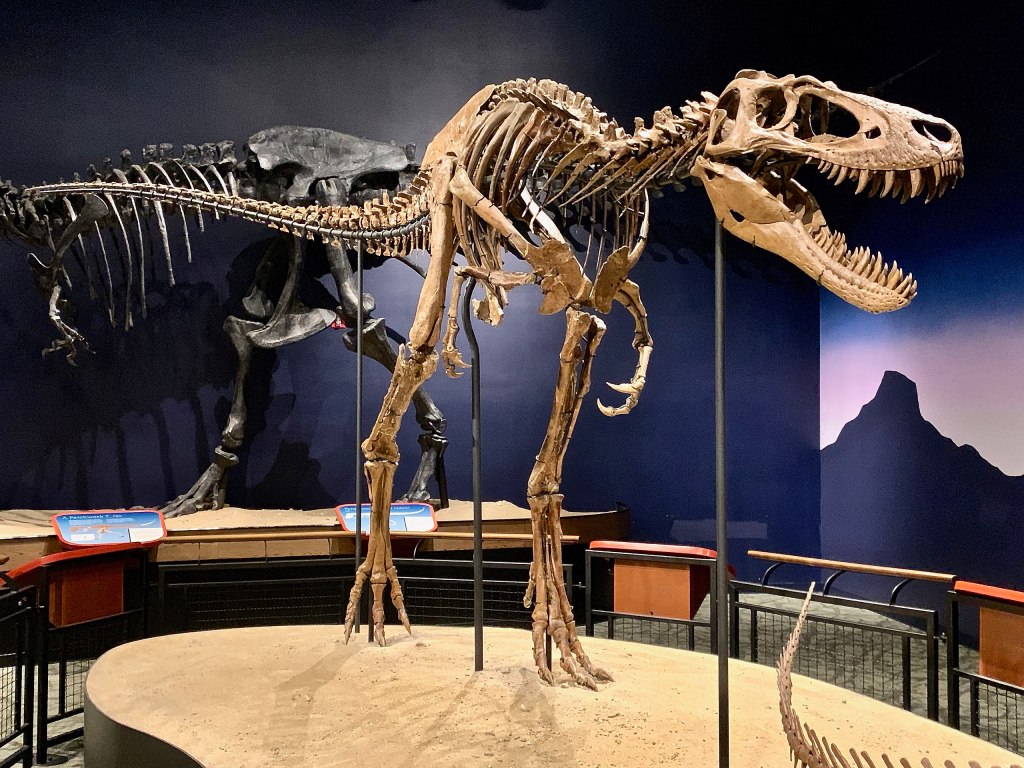
Only two confirmed specimens of Nanotyrannus have been identified. The holotype (original), which is known as the “Cleveland specimen,” consists of a skull discovered in 1942. While the features were clearly Tyrannosaurine, namely the fused nasal bones and conical teeth, the absence of a full skeleton left paleontologists oblivious to Nanotyrannus’ true appearance. The second, discovered in 2002, gave a much more complete view. Nicknamed “Jane,” the specimen was slender and resembled the albertosaurines, a subfamily of tyrannosaurids that includes Gorgosaurus and Albertosaurus. This resemblance between Nanotyrannus and early tyrannosaurids has always been apparent: the holotype was thought to be a specimen of Gorgosaurus for 46 years!
Nanotyrannus’ resemblance to the albertosaurines led paleontologists, including Robert Bakker and Phil Currie, to theorize that it was a later surviving genus of the order. This resemblance – coupled with the dissimilarity between it and Tyrannosaurus – forms the backbone of the argument that it was its own species. I mean, look at Nanotyrannus and Tyrannosaurus next to each other. Can you make out a resemblance?
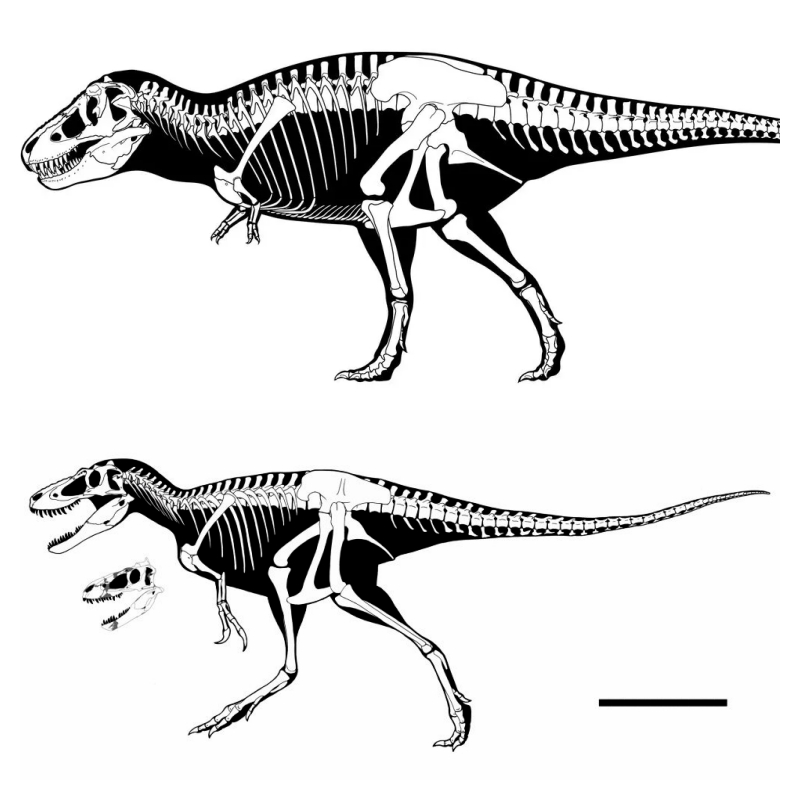
If you had difficulty seeing the similarities, I don’t blame you! Tyrannosaurus is famous for its bulk and stockiness, while Nanotyrannus was as slender as they come. The skull of Tyrannosaurus is broad and heavily reinforced, while Nanotyrannus is narrow. Tyrannosaurus grew to over 13 meters long and weighed over five tonnes; Nanotyrannus was half as long and didn’t even weigh a tonne! With such vast differences in appearance and size, how could paleontologists believe that Nanotyrannus is actually Tyrannosaurus?
It all has to do with age. Analysis of the two Nanotyrannus specimens revealed they were both adolescents, with Jane being around 11 years old and the Cleveland specimen being even younger. Similar analysis shows that the massive Tyrannosaurus specimens were all mature individuals, with most being in their 20’s and none living past 28. Since no adult Nanotyrannus has ever been discovered, and no other Tyrannosaurids lived in North America at the time, Tyrannosaurus is the only current candidate for the adult stage of Nanotyrannus.

That’s interesting, but what about the differences in appearance? Well, it turns out that Tyrannosaurus may have gone through very dramatic puberty! By examining fossils across various growth stages, paleontologists have revealed that Tyrannosaurus underwent a period of drastic growth in its early teens, starting in its early teens. In the span of about nine years, Tyrannosaurus grew at an astronomical rate which eventually levelled off in their twenties. At its developmental peak, it’s possible that Tyrannosaurus gained over 750 kilograms (1,500 pounds) annually! And you thought your growth spurt was intense!
On top of this, Nanotyrannus’ skull was almost identical structurally to Tyrannosaurus. Proposed differences between the two – namely the number of teeth in their jaws – aren’t enough to distinguish them. After all, baby humans have 20 teeth in their mouths while adults have 32. Since tooth count doesn’t make babies a different species, then neither should it for Nanotyrannus! This doesn’t even account for the fact that other tyrannosaurids had different numbers of teeth between ages, further invalidating the argument.
The physical similarities seem to indicate that the skull broadened and became more defined into adulthood. This isn’t too surprising, as many other dinosaur species experienced drastic changes in skull shape during adolescence; take Triceratops for example. When you think about it, this probably would have been for the best. I imagine that having a two-meter-long head wouldn’t have been the most comfortable experience for a juvenile Tyrannosaurus…
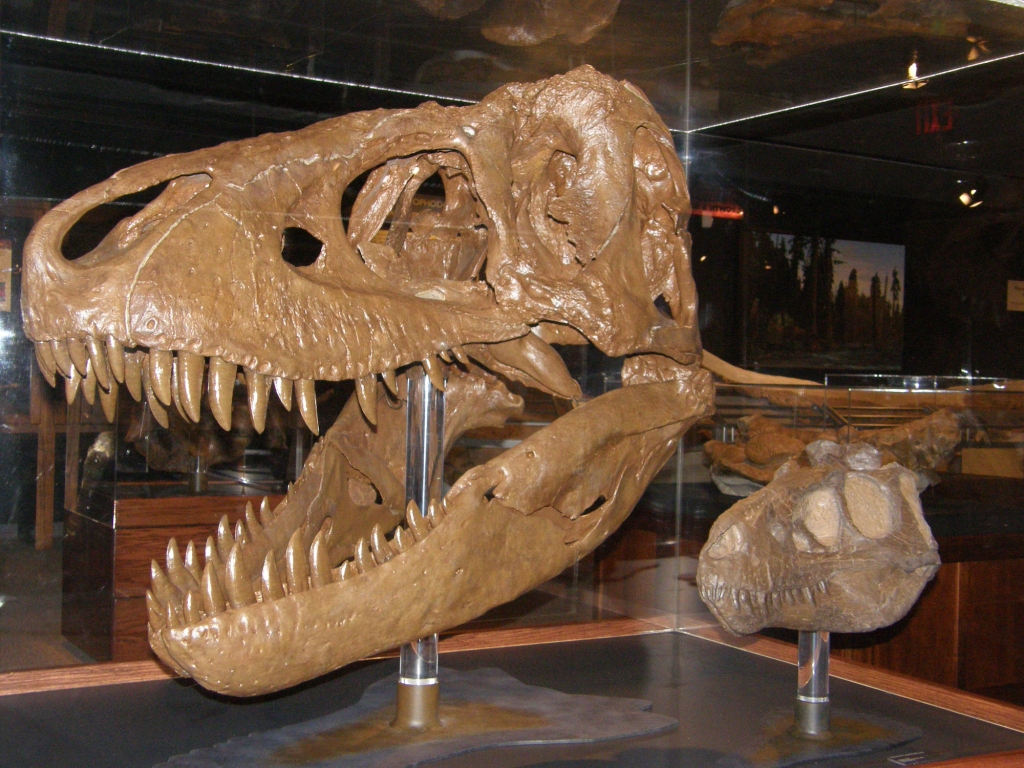
Other differences can also be chalked up to maturation. Nanotyrannus being skinnier than Tyrannosaurus? Most juveniles in the animal kingdom are. Tiny arms on Tyrannosaurus compared to long arms on Tyrannosaurus? As their body grew, their arms didn’t since they didn’t serve a purpose for adults. The evidence points toward Nanotyrannus being a juvenile Tyrannosaurus, just as lanky and awkward as their human counterparts.
But why were the juveniles so different from adults? The answer may lie in what they were hunting. Juvenile Tyrannosaurus’ were too small to hunt well-defended prey like Triceratops or Ankylosaurus, but they were well-equipped for smaller prey. Herbivores like Pachycephalosaurus and Thescelosaurus were about the right size for juvenile Tyrannosaurs and not heavily defended, but they were quick and agile. To better catch them, juvenile Tyrannosaurus were built for speed and maneuverability.
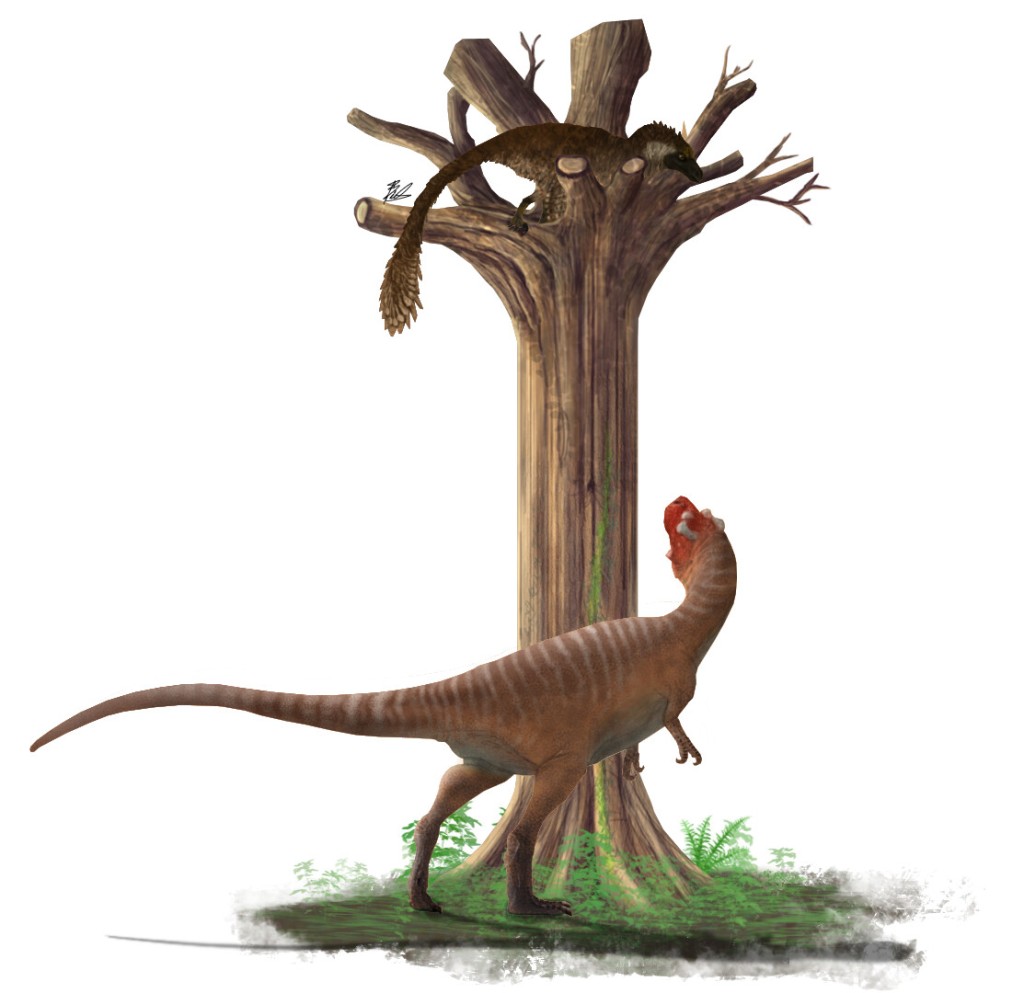
As they transitioned to larger and armoured prey, they became built for power when speed was no longer an advantage. By occupying multiple ecological niches at different stages of life, Tyrannosaurus was able to dominate its habitat with brutal efficiency. Juvenile Tyrannosaurs likely outcompeted other predators, as fossil sites with Tyrannosaurus typically lack other predatory dinosaurs bigger than 100 kilograms.
As it stands, more paleontologists support the juvenile Tyrannosaurus hypothesis. I agree with this, as the evidence in favour far outweighs the counterarguments. In my opinion, the lack of an adult Nanotyrannus specimen renders the discussion moot. If two large tyrannosaurids did live together, then why do we have a plethora of adult specimens from one but none from the other?
It should be noted that a potential third specimen may provide further insight. Despite being discovered over a decade ago, the remains of a tyrannosaurid locked in combat with a Triceratops are only now being examined by the public. Representing one-half of the “Dueling Dinosaurs”, the tyrannosaurid supposedly settles the Nanotyrannus debate, though this finality remains to be seen.
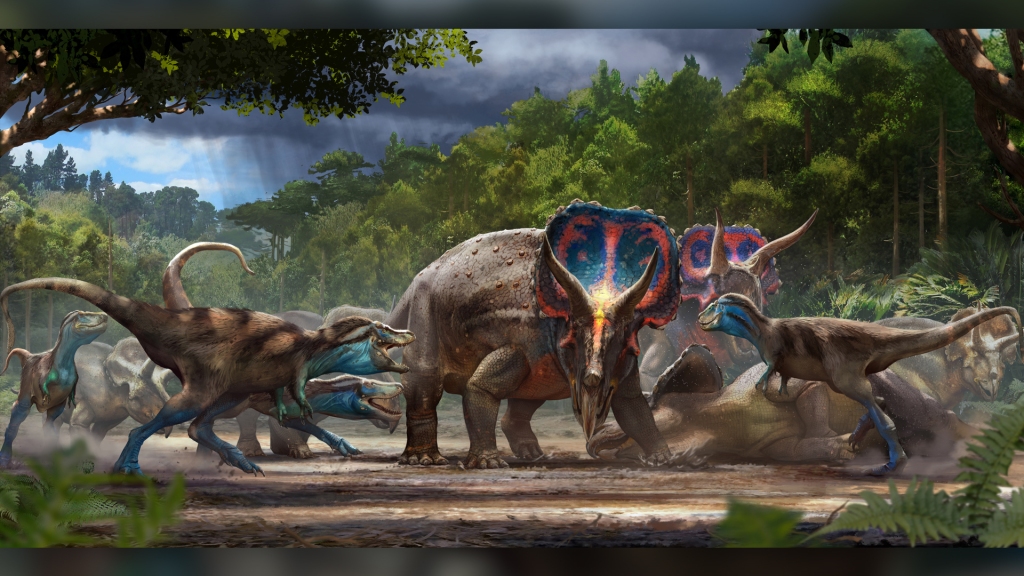
Some paleontologists will always argue for Nanotyrannus. Perhaps the notion of two tyrannosaurids living together is too interesting for them to ignore. It’s more likely thatthey simply refuse to go down with the sinking ship that is Nanotyrannus. Paleontologists (and scientists more generally) are a prideful bunch, after all. Who are other paleontologists to tell them that Nanotyrannus was just a teenaged Tyrannosaurus?
Have a happy new year!
Works Cited:
I do not take credit for any image found in this article.
Header image, “The smell of carrion” courtesy of amorousdino on DeviantArt, whose work can be found here
Jane courtesy of Wikimedia, found here
Tyrannosaurus skeleton found here
Nanotyrannus skeleton courtesy of Brett Booth on twitter, found here
“Growing up Cretaceous” courtesy of r-heinart, found at their DeviantArt here
Juvenile and adult skulls courtesy of the Thomas Carr and the Museum of the Rockies, found here
Juvenile Tyrannosaurus hunting Archeroraptor courtesy of Gabriel Andrade, found here
Triceratops herd vs Tyrannosaurs courtesy of Anthony Hutchings and the North Carolina Museum of Natural Sciences, found here
Benton, M. J. The Dinosaurs Rediscovered: How A Scientific Revolution Is Rewriting History. Thames and Hudson, 2020.
Black, Riley. “Tiny Terror: Controversial Dinosaur Species Is Just an Awkward Tween Tyrannosaurus.” Smithsonian.com, Smithsonian Institution, 28 Oct. 2015, https://www.smithsonianmag.com/science-nature/tiny-terror-controversial-dinosaur-species-just-awkward-tween-tyrannosaurus-180957084/.
Brusatte, Stephen L., et al. “Dentary Groove Morphology Does Not Distinguish ‘Nanotyrannus’ as a Valid Taxon of Tyrannosauroid Dinosaur. Comment on: ‘Distribution of the Dentary Groove of Theropod Dinosaurs: Implications for Theropod Phylogeny and the Validity of the Genus Nanotyrannus Bakker Et Al., 1988.’” Cretaceous Research, vol. 65, 2016, pp. 232–237., https://doi.org/10.1016/j.cretres.2016.02.007.
E., Hone David W, and Scott Hartman. The Tyrannosaur Chronicles: The Biology of the Tyrant Dinosaurs. Bloomsbury Sigma, an Imprint of Bloomsbury Publishing Plc, 2017.
Geggel, Laura. “Meet Jane, the Most Complete Adolescent T. Rex Ever Found.” LiveScience, Purch, 19 Oct. 2015, https://www.livescience.com/52510-adolescent-t-rex-jane.html.
Parrish, J. Michael, et al. Tyrannosaurid Paleobiology. Indiana University Press, 2013.
Woodward, Holly N., et al. “Growing up Tyrannosaurus Rex: Osteohistology Refutes the Pygmy ‘Nanotyrannus’ and Supports Ontogenetic Niche Partitioning in Juvenile Tyrannosaurus.” Science Advances, vol. 6, no. 1, 2020, https://doi.org/10.1126/sciadv.aax6250.
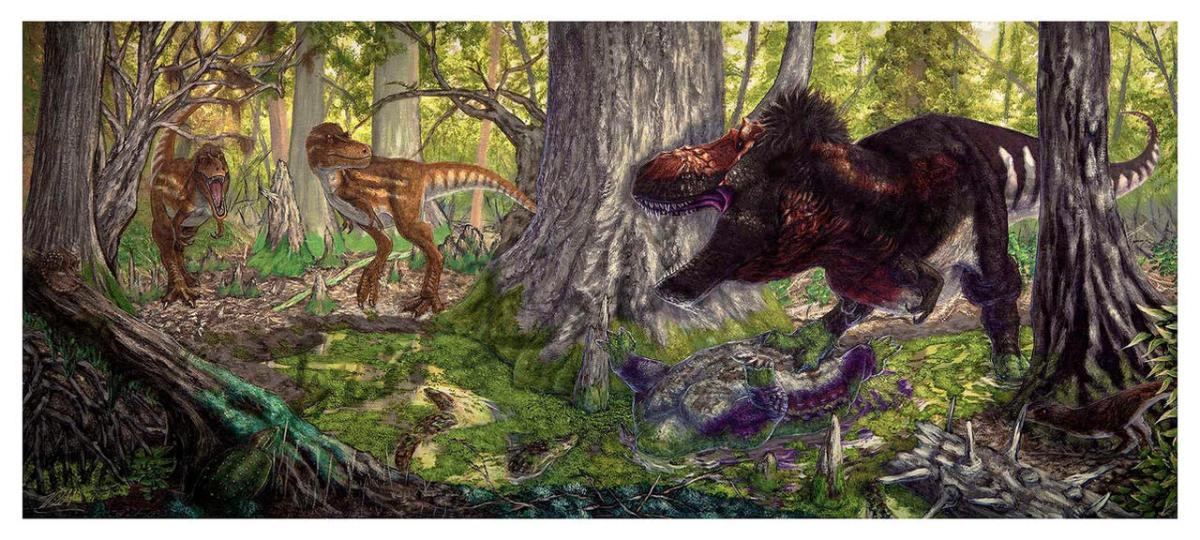
5 replies on “Did Nanotyrannus Exist?”
[…] potential species: Nanotyrannus and Tarbosaurus. Nanotyrannus, the mid-sized tyrannosaurid that may or may not have been a juvenile Tyrannosaurus, is never mentioned under any of Paul’s species. Does it represent a juvenile T. rex? A juvenile […]
LikeLike
[…] history and physiology. We are informed of some of its most notable controversies (such as the status of Nanotyrannus and the topic of feathers), while others (Greg Paul’s three Tyrannosaurus species) are omitted. […]
LikeLike
[…] Tyrannosaurus rex or a distinct species called Nanotyrannus. While paleontologists have argued for both sides, my money is on the baby-rex theory. Broken Tooth: And I thought Cavities hurt! Located in the […]
LikeLike
[…] While last year’s study examined the intelligence of T. rex, this year’s paper focuses on the taxonomic status of Nanotyrannus lancensis and its relation to T. rex. For those blissfully unaware, the issue boils down to a handful of mid-sized Tyrannosaurid specimens from North America that date back to the end-Cretaceous. The small size and differing morphology of these individuals have led some to proclaim them to be a unique genus – Nanotyrannus – while other paleontologists cite the immature age of each specimen as evidence that they were juveniles of Tyrannosaurus rex. Both sides have valid arguments, but the prevailing view is that these individuals were immature T. rex. (For a more thorough examination of Nanotyrannus, follow the following link!) […]
LikeLike
[…] Thank you for reading today’s article! Following the time of Gorgosaurus, the teenage offspring of Tyrannosaurus were wreaking havoc across the American West – or were they a different species? If you want to know the truth about Nanotyrannus, I suggest reading it here at Max’s Blogosaurus! […]
LikeLike